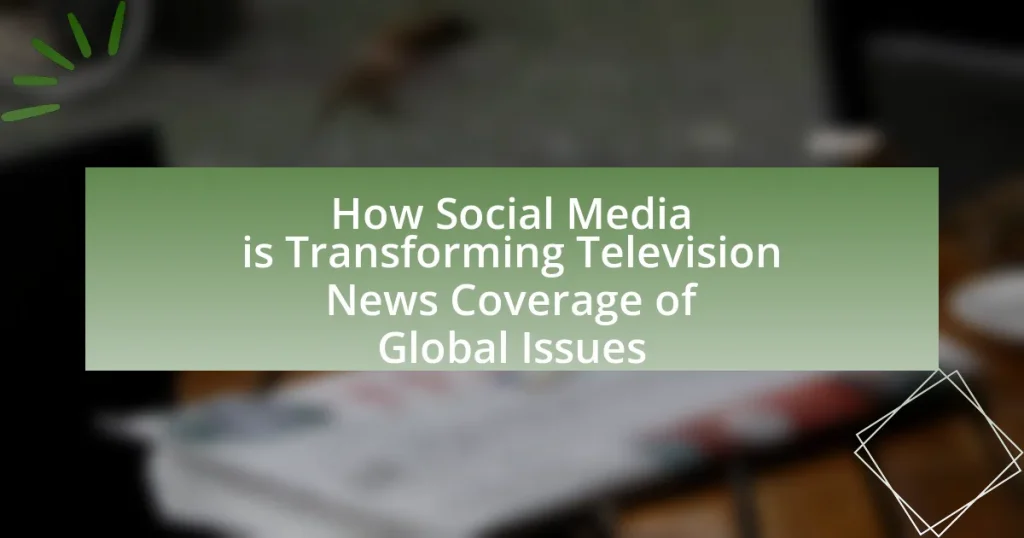Social media is fundamentally transforming television news coverage of global issues by enabling real-time reporting, enhancing audience engagement, and facilitating the incorporation of diverse perspectives. This shift allows news organizations to quickly gather information from various sources, including user-generated content, which enriches the depth and immediacy of reporting. The article explores the role of social media in shaping public perception, influencing news story selection, and the impact of user-generated content on credibility and audience trust. It also addresses the challenges faced by television news in adapting to social media trends and highlights best practices for effective integration of these platforms in news reporting.

How is Social Media Transforming Television News Coverage of Global Issues?
Social media is transforming television news coverage of global issues by enabling real-time reporting and audience engagement. This shift allows news organizations to gather information quickly from diverse sources, including eyewitness accounts and user-generated content, which enhances the depth and immediacy of coverage. For instance, during the Arab Spring, platforms like Twitter and Facebook played crucial roles in disseminating information and mobilizing public opinion, leading to a more dynamic and participatory news environment. Additionally, social media facilitates direct interaction between news outlets and viewers, allowing for immediate feedback and the incorporation of audience perspectives into news narratives. This evolution reflects a significant change in how global issues are reported, making coverage more inclusive and responsive to public discourse.
What role does social media play in shaping public perception of global issues?
Social media significantly influences public perception of global issues by providing a platform for rapid information dissemination and diverse viewpoints. It allows users to share news, opinions, and personal experiences, which can shape collective understanding and attitudes toward events such as climate change, humanitarian crises, and political movements. For instance, during the Arab Spring, social media was pivotal in mobilizing protests and raising global awareness, demonstrating its power to alter perceptions and drive action. Research indicates that 62% of adults in the U.S. get news from social media, highlighting its role as a primary information source that can sway public opinion and influence policy discussions.
How do social media platforms influence the selection of news stories?
Social media platforms influence the selection of news stories by prioritizing content that generates high engagement, such as likes, shares, and comments. This engagement-driven model leads news organizations to focus on sensational or trending topics that resonate with users, often at the expense of more nuanced or critical issues. For instance, a study by the Pew Research Center found that 62% of adults in the U.S. get news from social media, indicating that platforms like Facebook and Twitter shape public discourse by amplifying stories that attract attention, regardless of their journalistic merit. Consequently, this can result in a skewed representation of important global issues, as media outlets adapt their coverage to align with the preferences of social media audiences.
What impact does user-generated content have on television news coverage?
User-generated content significantly enhances television news coverage by providing real-time, diverse perspectives and firsthand accounts of events. This immediacy allows news outlets to report on breaking stories more quickly and accurately, as seen during events like the Arab Spring, where citizen footage and social media posts played a crucial role in shaping narratives. Furthermore, user-generated content fosters greater audience engagement, as viewers feel more connected to the news when they see contributions from their peers. Studies indicate that incorporating such content can increase viewer trust and credibility in news organizations, as it reflects a broader range of voices and experiences.
Why is the integration of social media important for television news outlets?
The integration of social media is important for television news outlets because it enhances audience engagement and expands reach. By utilizing platforms like Twitter, Facebook, and Instagram, news outlets can interact with viewers in real-time, allowing for immediate feedback and participation in discussions. According to a Pew Research Center study, 62% of adults get news from social media, indicating that these platforms are crucial for reaching a broader audience. Furthermore, social media serves as a valuable tool for breaking news dissemination, enabling outlets to share updates quickly and effectively, which is essential in today’s fast-paced information environment.
How does social media enhance audience engagement with news content?
Social media enhances audience engagement with news content by facilitating real-time interaction and feedback between news organizations and their audiences. This immediacy allows users to comment, share, and discuss news stories, creating a dynamic dialogue that increases viewer investment in the content. According to a Pew Research Center study, 62% of adults in the U.S. get news from social media, indicating that these platforms serve as primary sources for news consumption. Furthermore, social media algorithms prioritize engaging content, which encourages news outlets to create more interactive and visually appealing stories, further driving audience participation.
What are the challenges television news faces in adapting to social media trends?
Television news faces significant challenges in adapting to social media trends, primarily due to the rapid pace of information dissemination and the demand for real-time reporting. Traditional news outlets struggle to keep up with the speed at which news breaks on social media platforms, often resulting in outdated or less relevant coverage. Additionally, the shift towards user-generated content complicates the verification process, as television news must balance the need for timely updates with the necessity of ensuring accuracy and credibility. According to a Pew Research Center study, 62% of Americans get news from social media, highlighting the urgency for television news to engage with these platforms effectively while maintaining journalistic standards.
What changes have occurred in the way global issues are reported on television?
Global issues are now reported on television with greater immediacy and interactivity due to the influence of social media. Traditional news formats have evolved to incorporate real-time updates and audience engagement, allowing viewers to participate in discussions and share their perspectives. For instance, news outlets often utilize platforms like Twitter and Facebook to gather live reactions and incorporate user-generated content into their broadcasts, enhancing the narrative with diverse viewpoints. This shift has been driven by the need for news organizations to remain relevant in a rapidly changing media landscape, where audiences expect instant access to information and a more participatory role in news consumption.
How has the speed of news reporting changed due to social media?
The speed of news reporting has significantly increased due to social media, enabling real-time dissemination of information. Traditional news outlets, which previously required time for verification and editing, now face pressure to publish updates instantly as events unfold. For instance, during major events like the Arab Spring, social media platforms allowed citizens to share news faster than traditional media could report, leading to a shift in how news is gathered and shared. This immediacy has transformed the landscape of journalism, where breaking news can reach global audiences within seconds, fundamentally altering public access to information.
What new formats are being adopted in television news as a result of social media?
Television news is adopting new formats such as live streaming, short-form video segments, and interactive content due to the influence of social media. Live streaming allows real-time reporting and audience engagement, which is essential for breaking news coverage. Short-form video segments, often under two minutes, cater to the fast-paced consumption habits of social media users, making news more accessible. Interactive content, including polls and Q&A sessions, fosters viewer participation and enhances the overall news experience. These formats reflect the need for immediacy and engagement in a digital landscape where social media plays a pivotal role in shaping audience expectations.
How do social media platforms affect the credibility of television news coverage?
Social media platforms significantly undermine the credibility of television news coverage by facilitating the rapid spread of misinformation. Research indicates that false information spreads six times faster than true information on social media, as shown in a study published in the journal Science by Vosoughi, Roy, and Aral in 2018. This rapid dissemination leads to public confusion and skepticism towards traditional news sources, as audiences often encounter conflicting narratives online. Consequently, television news outlets face pressure to compete with the immediacy of social media, which can result in rushed reporting and a decline in journalistic standards.
What are the ethical considerations for television news in the age of social media?
Television news must navigate several ethical considerations in the age of social media, primarily focusing on accuracy, accountability, and the potential for misinformation. The rapid dissemination of information through social media platforms can lead to the spread of unverified or false news, which television news organizations must counteract by ensuring rigorous fact-checking and verification processes. Additionally, the pressure to be first in reporting can compromise journalistic standards, leading to sensationalism or incomplete narratives. Ethical guidelines also emphasize the importance of transparency, requiring news outlets to disclose sources and methodologies to maintain public trust. Furthermore, the impact of social media algorithms on news visibility raises concerns about bias and the representation of diverse viewpoints, necessitating a commitment to fairness and inclusivity in reporting. These considerations are critical as they shape the integrity and credibility of television news in a rapidly evolving media landscape.
What specific global issues have been notably impacted by social media in television news?
Social media has notably impacted global issues such as climate change, political unrest, and public health crises in television news coverage. For instance, during the COVID-19 pandemic, platforms like Twitter and Facebook facilitated rapid dissemination of information, influencing how news outlets reported on health guidelines and vaccine developments. Additionally, social media played a crucial role in the Arab Spring, where real-time updates and citizen journalism shaped television narratives around political movements. Research indicates that 64% of journalists use social media to gather news, highlighting its significance in shaping public discourse on these critical global issues.
How has social media coverage changed the narrative around climate change?
Social media coverage has significantly shifted the narrative around climate change by amplifying diverse voices and increasing public engagement. Platforms like Twitter and Instagram allow activists, scientists, and everyday individuals to share real-time updates, personal stories, and visual content, which fosters a sense of urgency and community around climate issues. For instance, the viral spread of the #FridaysForFuture movement, initiated by Greta Thunberg, mobilized millions globally, demonstrating how social media can catalyze grassroots activism and influence policy discussions. This shift has led to a more inclusive dialogue, challenging traditional media narratives that often underrepresented marginalized communities affected by climate change.
What role does social media play in reporting on humanitarian crises?
Social media serves as a critical platform for reporting on humanitarian crises by facilitating real-time information sharing and amplifying voices from affected communities. It enables journalists and organizations to disseminate updates quickly, often surpassing traditional media timelines. For instance, during the Syrian refugee crisis, platforms like Twitter and Facebook were instrumental in sharing firsthand accounts and images, which garnered global attention and mobilized humanitarian aid. Additionally, social media allows for direct engagement between reporters and the public, fostering a more interactive dialogue about ongoing crises. This immediacy and accessibility of information have transformed how humanitarian issues are covered, making social media an essential tool in modern journalism.
What best practices should television news outlets adopt for effective social media integration?
Television news outlets should adopt a multi-platform strategy for effective social media integration. This involves creating tailored content for each social media platform, ensuring that the format and messaging resonate with the specific audience of that platform. For instance, short video clips work well on platforms like TikTok and Instagram, while in-depth articles may be more suitable for Facebook and Twitter.
Additionally, engaging with the audience through interactive content, such as polls and live Q&A sessions, fosters community and encourages viewer participation. Research indicates that news organizations that actively engage with their audience on social media see higher levels of viewer trust and loyalty. Furthermore, utilizing analytics tools to track engagement metrics allows news outlets to refine their strategies based on audience preferences and behaviors, leading to more effective content delivery.




